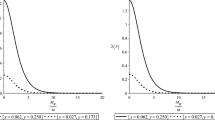Summary
A theory of the intermediate vector boson is proposed, in which the boson field can be described by a renormalizable Lagrangian in an indefinite-metric space. The circumstances under which an indefinitemetric space can be consistently applied are discussed. It is shown that for very massive bosons (M∼2500 proton masses) the indefinite metric of the space does not conflict with requirements of probability conservation. The coupling constant for the lepton-intermediate boson interaction is approximately given byg 2∼10−1 in this theory.
Riassunto
Si propone una teoria del bosone vettoriale intermedio, in cui il campo bosonico può essere descritto da una lagrangiana rinormalizzabile in uno spazio di metrica indefinita. Si discutono le circostanze in cui si può applicare coerentemente uno spazio di metrica indefinita. Si mostra che per bosoni di grande massa (M∼2500 masse protoniche) la metrica indefinita dello spazio non contrasta con le condizioni di conservazione della probabilità. In questa teoria la costante d'accoppiamento per l'interazione leptonebosone intermedio è data approssimativamente dag 2∼10−1.
Резюме
Предлагается теория промежуточного векторного бозона, в которой бозонное поле может быть описано с помощью перенормируемого Лагранжиана в пространстве с неопределенной метрикой. Обсуждаются условия, при которых пространство с неопределенной метрикой может быть последовательно использовано. Показывается, что для очень массивных бозонов (M∼2500 масс протона) неопределенная метрика пространства не находится в противоречии с требованиями сохранения вероятности. В этой теории константа связи при взаимодействии лептона с промежуточным бозоном приблизительно равнаg 2∼10−1.
Similar content being viewed by others
References
W. Heisenberg:Zeits. f. Phys.,101, 533 (1936).
A. Pais:Weak Interactions at High Energies, inTheoretical Physics (Vienna, 1963).
See, for example,R. E. Marshak:Meson Physics, Chapter 7 (New York, 1952).
S. Treiman:Structure of the Weak Interactions, inLecture Notes on Weak Interactions, edited byC. Fronsdal (New York, 1963).
T. D. Lee andC. N. Yang:Phys. Rev.,119, 1410 (1960).
G. Feinberg andF. Gürsey:Phys. Rev.,128, 378 (1962).
L. Durand, L. F. Landovitz andR. B. Marr:Phys. Rev.,130, 1188 (1963).
Some consequences of the use of this Lagrangian have been discussed byZ. Bialynicki-Birula:Nuovo Cimento,21, 571 (1961);G. Dorman:Nuovo Cimento,32, 1226 (1964).
S. N. Gupta:Proc. Phys. Soc.,63, 681 (1950);64, 850 (1951);K. Bleuler:Helv. Phys. Acta,23, 567 (1950).
I. Goldberg, K. Haller andL. F. Landovitz:Phys. Rev.,144, 1171 (1966).
The Lagrangian for the spin-1 field is discussed in:N. N. Bogoliubov andD. V. Shirkov:Introduction to the Theory of Quantized Fields (New York, 1959);H. Umezawa:Quantum Field Theory (Amsterdam, 1956);G. Wentzel:Quantum Theory of Fields (New York, 1949).
R. Ascoli andE. Minardi:Nucl. Phys.,9, 242 (1958);L. A. Maksimov:Žurn. Ėksp. Teor. Fiz.,36, 465 (1959);K. L. Nagy:Suppl. Nuovo Cimento,17, 760 (1960);L. K. Pandit:Suppl. Nuovo Cimento,11, 157 (1959);H. J. Schnitzer andE. C. G. Sudarshan:Phys. Rev.,123, 2193 (1961);E. C. G. Sudarshan:Phys. Rev.,123, 2183 (1961);A. Uhlmann:Nucl. Phys.,12, 103 (1959).
L. K. Pandit:Suppl. Nuovo Cimento,11, 157 (1959);K. L. Nagy:Suppl. Nuovo Cimento,17, 760 (1960).
L. K. Pandit:Suppl. Nuovo Cimento:11, 157 (1959).
J. M. Jauch andF. Rohrlich:The Theory of Photons and Electrons (Reading, Mass., 1955), Chapter 6.
K. L. Nagy:Suppl. Nuovo Cimento,17, 760 (1960).
The term «reduction» is used in the sense explained in:E. Wigner:Am. Journ. Phys.,31, 6 (1963).
J. Schwinger:Ann. of Phys.,2, 407 (1957). In this article, the author suggested that a σ particle of this type existed; he did not, however, discuss the rationale for the unobservability in any detail.
M. Veltman:Physica,29, 186 (1963).
See, for example,A. Pais:Weak Interactions at High Energies, inTheoretical Physics (Vienna, 1963).
A. Pais:Weak Interactions at High Energies, inTheoretical Physics (Vienna, 1963), (see ref. (35) in this paper).
Author information
Authors and Affiliations
Additional information
Supported by the National Science Foundation and the University of Connecticut Research Foundation.
Supported by the National Science Foundation and the National Aeronautics and Space Administration.
Traduzione a cura della Redazione.
Переведено редакцией.
Rights and permissions
About this article
Cite this article
Haller, K., Landovitz, L.F. & Goldberg, I. Intermediate vector bosons as unobservable particles. Nuovo Cimento A (1965-1970) 48, 303–319 (1967). https://doi.org/10.1007/BF02818007
Received:
Published:
Issue Date:
DOI: https://doi.org/10.1007/BF02818007



